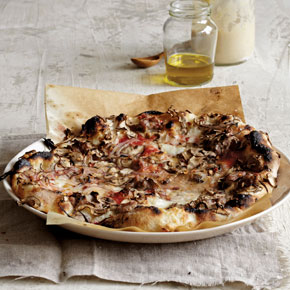A Pizza Worth Having
September 28, 2012

IT is rare that I have positive news to relay. Today is an exception. Thanks to the trendy New York City baker Jim Lahey, I have found an outstanding recipe for homemade pizza crust.
This dough is exceptional. Like all low-yeast breads, it tastes more fully of wheat and has the light, bubbly texture that is commonly associated with “artisan” breads. It is very easy to make as it involves no kneading. It does need to rise for 18 hours, however, so you make it the day before.
The recipe is from Lahey’s book, My Pizza, which I borrowed from my local library, and is available at the Bon Appetit website here. Lahey has his own website with a few recipes for the book’s pizza toppings, such as the Boscaiola pie (above), which comes with pork sausage, mushrooms, tomato sauce and red onions. His topping combinations are very good. He has an interesting way of broiling pizzas to give them a charred, wood-fired taste. One can also just cook the pies in a very hot oven.
By the way, Lahey, who started the Sullivan Street Bakery in New York, has observations about the industrialization of pizza that will be familiar to any reader of this site. This is an issue that unites right and left. In the introduction to his pizza book, Lahey writes:
[I] want to weep when I think how industrialized (with a few exceptions) this simple food has become. … Isn’t a parlor supposed to be a pleasant place where bright people gather to talk, enjoy each other’s company, share ideas? A beauty parlor offers more creativity than your average American pizza parlor, a garish, harried place where floppy pies made from trashy ingredients are turned out over and over again — until customers are persuaded that this experience is somehow a good thing.
People may have shared ideas before over a Domino’s or Papa John’s pie, but they haven’t been good ideas, have they? Think about it. Do you know anyone who has said anything halfway interesting after eating cardboard slathered with vinyl cheese?
The quality of academic life has demonstrably declined with the rise of pizza deliverymen on American campuses. It’s not possible to breathe, let alone think, after eating a hot-dog stuffed crust. Students paying more than $50,000 a year for a college education routinely consume pizza at night in their dorms, trying to fill the hole created by courses in the dissolution of their own culture. After four years of this, they can barely spell, “how r u?” on their Iphones, let alone think.
Man is a composite being and pizza, whether it be good or bad, affects every darn bit of him.
—- Comments —–
Jane S. writes:
I never thought about the evolving role of pizza until I started reading your blog. As you may recall, I grew up in a little cowtown in the middle of the Bible Belt. There was a Pizza Hut, but pizza was not ubiquitous the way it is now. I had it only rarely, at parties and sleepovers at friends’ houses, never at home. My dad hated restaurants and we almost never ate out. He probably never ate pizza even once in his whole life. But he used to enjoy canned stewed tomatoes poured over bread, so maybe that’s not so different.
Hurricane Betsy writes:
Thank you very much for linking to the recipe for No-Knead pizza dough. The ingredients in this method do their work through slow overnight “fermentation,” not true fermentation, I don’t think, but anyway, it is far healthier than the 3-hours-raised bread dough. Also, this method shows us we shouldn’t be in such a rush all the time. Good things take time. Since rediscovering slow bread rising a couple of years ago, I won’t make bread any other way now. I’m not ancient but I am old enough to recall bread being left to rise overnight. Honest!
Laura writes:
You’re welcome. I’m not sure what you mean by “not true fermentation.” Doughs such as this, which use much less yeast and take longer to rise, pick up wild yeasts in the environment. It is still a form of fermentation. The high quantity of reconstituted, dried yeast in breads that sit for a shorter period of time has a major drawback. The taste of the yeast overwhelms the taste of the grain. The slow-rising process on its own also gives the wheat a fuller taste. I think most people would prefer bread with a long rise or made with a starter in a taste test.
Even with normal recipes that call for the bread to rise in a couple of hours, I usually reduce the yeast by at least a third and add more time.
